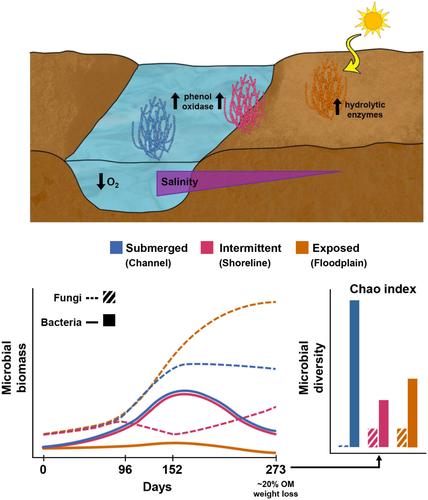当前位置:
X-MOL 学术
›
Environ. Microbiol.
›
论文详情
Our official English website, www.x-mol.net, welcomes your
feedback! (Note: you will need to create a separate account there.)
Differential response of bacteria and fungi to drought on the decomposition of Sarcocornia fruticosa woody stems in a saline stream
Environmental Microbiology ( IF 4.3 ) Pub Date : 2024-06-07 , DOI: 10.1111/1462-2920.16661 Anna Doménech-Pascual 1 , Lorena Carrasco-Barea 2 , Frederic Gich 3 , Judit Boadella 1 , Zeus Freixinos Campillo 4 , Rosa Gómez Cerezo 4 , Andrea Butturini 5 , Anna M Romaní 1
Environmental Microbiology ( IF 4.3 ) Pub Date : 2024-06-07 , DOI: 10.1111/1462-2920.16661 Anna Doménech-Pascual 1 , Lorena Carrasco-Barea 2 , Frederic Gich 3 , Judit Boadella 1 , Zeus Freixinos Campillo 4 , Rosa Gómez Cerezo 4 , Andrea Butturini 5 , Anna M Romaní 1
Affiliation

|
Inland saline ecosystems suffer multiple stresses (e.g., high radiation, salinity, water scarcity) that may compromise essential ecosystem functions such as organic matter decomposition. Here, we investigated the effects of drought on microbial colonization and decomposition of Sarcocornia fruticosa woody stems across different habitats in a saline watershed: on the dry floodplain, submerged in the stream channel and at the shoreline (first submerged, then emerged). Unexpectedly, weight loss was not enhanced in the submerged stems, while decomposition process differed between habitats. On the floodplain, it was dominated by fungi and high cellulolytic activity; in submerged conditions, a diverse community of bacteria and high ligninolytic activity dominated; and, on the shoreline, enzyme activities were like submerged conditions, but with a fungal community similar to the dry conditions. Results indicate distinct degradation paths being driven by different stress factors: strong water scarcity and photodegradation in dry conditions, and high salinity and reduced oxygen in wet conditions. This suggests that fungi are more resistant to drought, and bacteria to salinity. Overall, in saline watersheds, variations in multiple stress factors exert distinct environmental filters on bacteria and fungi and their role in the decomposition of plant material, affecting carbon cycling and microbial interactions.
中文翻译:

细菌和真菌对干旱对盐水溪中Sarcocornia fruticosa木本茎分解的差异反应
内陆盐分生态系统遭受多重压力(例如高辐射、盐度、缺水),可能会损害有机物分解等基本生态系统功能。在这里,我们研究了干旱对盐分流域不同栖息地的微生物定植和分解木本茎的影响:干燥的洪泛区、淹没在河道中和海岸线(先淹没,然后浮出)。出乎意料的是,浸没的茎的重量损失并没有增强,而且不同栖息地的分解过程不同。在洪泛区,真菌占主导地位,纤维素分解活性很高;在水下条件下,多样化的细菌群落和高木质素分解活性占主导地位;在海岸线上,酶活性类似于水下条件,但真菌群落类似于干燥条件。结果表明,不同的胁迫因素驱动了不同的降解路径:干燥条件下的严重缺水和光降解,以及潮湿条件下的高盐度和氧气减少。这表明真菌对干旱的抵抗力更强,而细菌对盐度的抵抗力更强。总体而言,在盐分流域中,多种胁迫因素的变化对细菌和真菌及其在植物材料分解中的作用产生了不同的环境过滤作用,影响碳循环和微生物相互作用。
更新日期:2024-06-08
中文翻译:

细菌和真菌对干旱对盐水溪中Sarcocornia fruticosa木本茎分解的差异反应
内陆盐分生态系统遭受多重压力(例如高辐射、盐度、缺水),可能会损害有机物分解等基本生态系统功能。在这里,我们研究了干旱对盐分流域不同栖息地的微生物定植和分解木本茎的影响:干燥的洪泛区、淹没在河道中和海岸线(先淹没,然后浮出)。出乎意料的是,浸没的茎的重量损失并没有增强,而且不同栖息地的分解过程不同。在洪泛区,真菌占主导地位,纤维素分解活性很高;在水下条件下,多样化的细菌群落和高木质素分解活性占主导地位;在海岸线上,酶活性类似于水下条件,但真菌群落类似于干燥条件。结果表明,不同的胁迫因素驱动了不同的降解路径:干燥条件下的严重缺水和光降解,以及潮湿条件下的高盐度和氧气减少。这表明真菌对干旱的抵抗力更强,而细菌对盐度的抵抗力更强。总体而言,在盐分流域中,多种胁迫因素的变化对细菌和真菌及其在植物材料分解中的作用产生了不同的环境过滤作用,影响碳循环和微生物相互作用。


















































 京公网安备 11010802027423号
京公网安备 11010802027423号